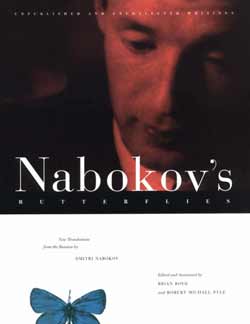Cover

Backcover

Index

Table of Contents  |
Nabokov's Butterflies: Unpublished and Uncollected
Writings
Author: Vladimir Nabokov
Genre: Various
Written: (2000)
Length: 721 pages
Original in: Russian, English, and French
Edition: Hardcover
- To purchase Nabokov's Butterflies
- Unpublished and Uncollected Writings 1908-1977
- Edited and annotated by Brian Boyd and Robert Michael Pyle
- Translated by Brian Boyd, and with "new translations from
the Russian by Dmitri Nabokov"
- Includes two introductions:
- Nabokov, Literature, Lepidoptera by Brian Boyd
- Between Climb and Cloud: Nabokov among the Lepidopterists
by Robert Michael Pyle
- Includes 53 illustrations and 31 colour plates
- Includes a list of Butterflies and Moths named by and for
Vladimir Nabokov, compiled by Robert Michael Pyle
Editorial Reviews from Amazon ©
From Publishers Weekly
Admirers of the great novelist Vladimir Nabokov (1899-1977) know
that collecting and classifying butterflies was for him not so much
a hobby as an obsession, especially during the 1940s, when he worked
for Harvard's Museum of Comparative Zoology and made important discoveries
about the American genera known as Blues. Butterfly-linked images
and ideas pervade some of his fiction, and butterfly-collecting
expeditions took up much of his free time. Nabokov biographer Boyd
and butterfly expert Pyle team up to offer a gigantic compendium
of butterfly-relevant Nabokoviana. Reprinted here are draft reminiscences
later revised for the autobiography Speak, Memory; the 1920 technical
paper "A Few Notes on Crimean Lepidoptera"; selected parts of the
later scientific and technical work; numerous poems with butterfly-related
lines, some in English, some translated from Russian; Nabokov's
last short story, "The Admirable Anglewing"; excerpts from letters
and interviews; notes for the New Yorker ("Incidentally, pinching
the thorax is a much simpler way of dispatching a butterfly") and
segments of Nabokov's lecture notes; and lepidopteran passages from
the novels and stories. Among the previously unpublished works,
one standout is the 36-page essay (originally in Russian) that Nabokov
meant to use as the afterword to The Gift. Also present are the
surviving fragments of Nabokov's never-completed descriptive catalogue,
Butterflies of Europe. Boyd and Pyle contribute separate, informative
and sometimes parallel introductions. Not even a Nabokov-obsessed
taxonomist would want to read this collection from start to finish:
it is, though, a volume devotees will delight to browse in and scholars
will want to own. 30 color and 30 b&w illus. Agent, Georges
Borchardt. (Apr.) FYI: For more information on Nabokov's Butterflies,
see Book News, Feb. 28.
Copyright 2000 Reed Business Information, Inc.
From Library Journal
The recent publication of Kurt Johnson and Steven L. Coates's Nabokov's
Blues (LJ 10/15/99) brought to light Nabokov's expertise in the
study of butterflies. The distinction of this new volume is that
it contains never-before-seen writings by Nabokov on the subject.
The book includes poems, letters, diary entries, interviews, and
technical articles that combine the author's passions for science
and literature. Nabokov biographer Boyd provides a lengthy introduction
that places Nabokov's studies within the context of his life. Nabokov's
son Dmitri presents a new translation, from the original Russian,
of "Father's Butterflies," a 36-page afterword to The Gift. Also
translated are 12 poems that had been unavailable in English. For
the specialist or the reader wanting to learn more about the scientific
side of Nabokov's life, there is much here to discover. Recommended
for academic libraries.
-Ronald Ray Ratliff, Emporia P.L., KS
Copyright 2000 Reed Business Information, Inc.
From Scientific
American
Most readers of Nabokov (the Russian-American author of Lolita and
other highly regarded works of fiction) know that he was interested
in butterflies, but it is doubtful that many of them are aware that
the level of his knowledge and his contributions to the field won
the respect of professional lepidopterists. Nabokov himself showed
the depth of his work in a letter of 1943 to literary critic Edmund
Wilson. "A summary of part of my scientific work on the Blues (the
Lycaeides genus-"Silver Studded Blues" in English) ... is due to
appear in a week or two. The labour involved has been immense; the
number of my index cards exceeds a thousand references-for half
a dozen (very polytypic) species; I have dissected and drawn the
genitalia of 360 specimens and unraveled taxonomic adventures that
read like a novel." The book that Boyd and Pyle have put together
gives a good picture of Nabokov's lepidoptery and reproduces many
of his drawings. It also offers much else in letters from and to
him about a variety of topics, in excerpts from interviews he gave,
and in his poems and prose on subjects other than butterflies. An
excellent companion to this compilation is Nabokov's Blues: The
Scientific Odyssey of a Literary Genius, by Kurt Johnson, a lepidopterist
who occupied Nabokov's former office at the American Museum of Natural
History, and writer Steven Coates (published in 1999 by Zoland Books
in Cambridge, Mass.).
EDITORS OF SCIENTIFIC AMERICAN
From Booklist
Nabokov's achievements as a lepidopterist are finally being accorded
the respect they deserve. Nabokov's Blues assessed his contributions
to science, and now this literary cornucopia illuminates further
his lifelong love affair with butterflies and the fruits of his
many years in the field and laboratory. In an introductory essay,
Brian Boyd, Nabokov's biographer, scrutinizes Nabokov's fascination
with patterns and metamorphosis; his penchant for solitude, delight
in discovery; and his sensitivity to beauty, themes that arise naturally
in Nabokov's own writings--nearly 70 years' worth of memoir, fiction,
poetry, letters, lectures, diary entries, and scientific articles
never before available to the general reader. In one indelible essay,
Nabokov observed that he has hunted butterflies "as a pretty boy
in knickerbockers and sailor cap; as a lanky cosmopolitan expatriate
in flannel bags and beret; as a fat hairless old man in shorts,"
and each of these incarnations is present here. Brilliant and playful,
Nabokov brought artistic sensuousness to science, and scientific
accuracy to literature, enriching both and leaving his readers in
awe. Donna Seaman
John Fowles in The Spectator, 15 April 2000
"Reading about [Nabokov's] exploits in this very rich book delighted
me...a pleasure to read...like some dream holiday or journey to
another land."
Excerpted from Nabokov's Butterflies : Unpublished and Uncollected
Writings by Vladimir Vladimirovich Nabokov, Brian Boyd, Robert
M. Pyle, Dmitri Nabokov. Copyright © 2000. Reprinted by permission.
All rights reserved
Vladimir Nabokov
From notes for interview with Jacob Bronowski, August 1963 For
an interview scheduled for British television but canceled before
filming because of Bronowski's health.
Product Description:
Newly translated works by Nabokov on the twin passions of his life,
literature and lepidoptera. A rich array of never-before-seen Nabokovia:
novels, stories, poems, autobiography, interviews, diaries, and
more, plus scientific and fanciful drawings by Nabokov and photographs
of him in the field. The text--the richest and most varied assemblage
of Nabokov's writing's available--is arranged chronologically and
introduced by Brian Boyd and Robert Michael Pyle
|



